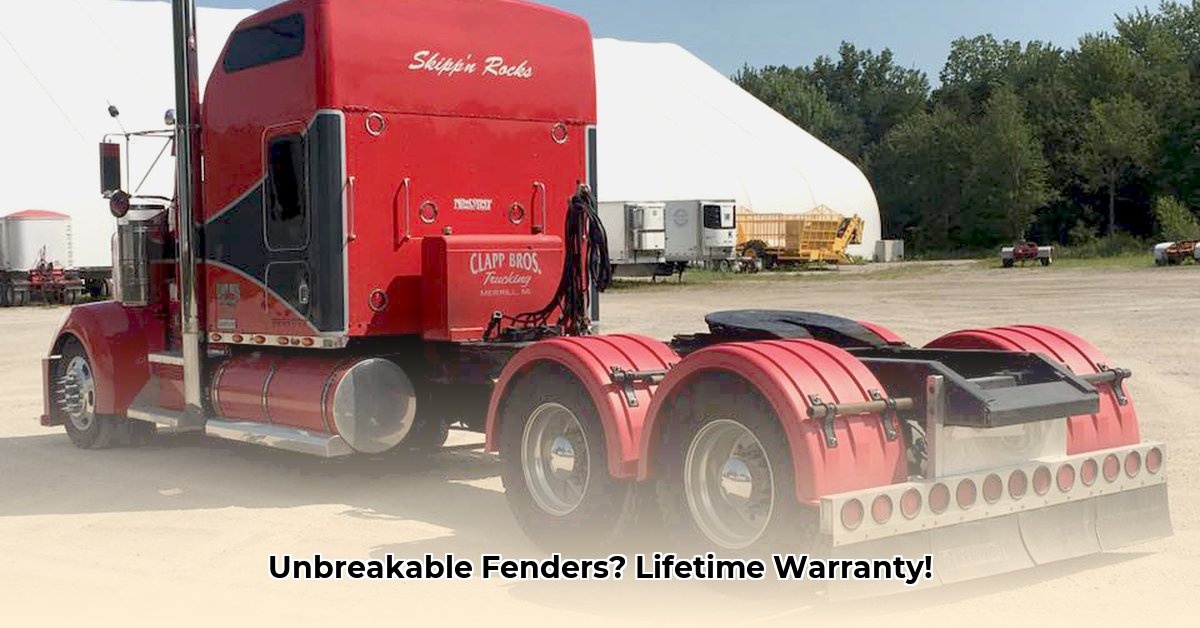
Semi Tractor Rear Fenders: Are Robmar Plastics the Right Choice for You?
Robmar Plastics semi-tractor rear fenders are gaining popularity in the trucking industry. But are these robust plastic fenders the right investment for your rig? This review examines their strengths and weaknesses to help you decide. For additional truck parts, check out these tractor parts.
Durability: A Tough Competitor
Unlike susceptible fiberglass or rust-prone metal fenders, Robmar utilizes high-density polyethylene (HDPE) – a remarkably durable plastic. Minor collisions that would dent metal or crack fiberglass barely faze these fenders. Dan H., an independent trucker from Western Illinois, attests: "These fenders have endured countless miles and harsh conditions, and they still look great!" David Boots Construction, Eastern Iowa, echoes this sentiment, noting their effectiveness in deflecting road grime and spray. This exceptional durability translates to significant long-term cost savings through reduced repair needs.
Are you tired of constantly repairing damaged fenders? Robmar's HDPE construction promises a significant reduction in maintenance costs.
Installation: Ease of Use
Robmar fenders boast a user-friendly, universal mounting system featuring powder-coated steel tubes, flexible nylon hangers, and a sturdy center bracket for tandem axles. An optional offset tube kit allows for customized placement. David Boots Construction found the installation process notably easier than with other fender systems, potentially saving substantial time and labor costs.
Could a simpler installation process save your fleet valuable time and money?
Lifetime Warranty: Peace of Mind
Robmar's impressive lifetime warranty underscores their confidence in the product's longevity. This commitment provides significant peace of mind, minimizing concerns about unexpected repair expenses. This warranty is a key differentiator in a competitive market.
Does a lifetime warranty offer you the assurance you need for a long-term investment?
Pricing: Value for Money?
While Robmar fenders are often competitively priced compared to metal or fiberglass alternatives, consider the long-term cost savings from reduced repairs. The combination of relatively low initial cost and the robust lifetime warranty makes a strong financial case.
How does the initial cost of Robmar fenders compare to the long-term costs of repairs and replacements for other materials?
Distribution Limitations: A Key Consideration
Robmar's distribution network is currently limited, primarily serving commercial addresses with loading docks. This restricts access for many independent truckers and smaller operations. This limitation is a significant factor to assess.
How will Robmar's limited distribution network impact your ability to acquire these fenders?
Weighing the Pros and Cons
The optimal choice depends on your priorities. A balanced perspective is crucial:
| Advantages | Disadvantages |
|---|---|
| Superior durability to metal/fiberglass | Limited distribution (commercial addresses only) |
| Significantly easier installation | Potential for longer shipping times |
| Competitive pricing | May require professional installation in some cases |
| Comprehensive lifetime warranty | Limited comparative data (strength, cost) |
| Made in the USA using efficient techniques |
How to Install Robmar Semi-Truck Poly Fenders (on a Non-Commercial Property)
This guide offers general instructions. Always refer to Robmar’s detailed instructions for your specific kit.
Pre-Installation: Preparation is Key
- Gather tools: wrench set, drill, measuring tape, level.
- Review Robmar's instructions for your kit (straight or offset).
- Deflate your truck's tires for optimal clearance.
Kit Selection: Straight or Offset?
Choose based on your truck's mounting points and desired fender position. Straight tubes are simpler; offsets provide greater flexibility, often preferred for tandem axles.
Step-by-Step Installation
- Precise Measurement: Accurately determine fender positions, ensuring at least 1.5 inches of tire clearance.
- 2x6 Spacers (Optional): Use for accurate alignment and even fender placement.
- Drilling and Mounting: Drill mounting holes (carefully!), then attach fenders to brackets.
- Secure Fastening: Tighten bolts gradually and evenly using a torque wrench.
- Final Inspection: Inflate tires and verify secure mounting, clearance, and alignment.
Key Takeaways and Potential Pitfalls:
- Maintain adequate tire clearance (1.5 inches minimum).
- Accurate measurements are crucial for proper alignment.
- Use a torque wrench to prevent over-tightening.
- Carefully choose the right kit for your truck configuration.
This detailed installation guide should assist you. Remember to consult Robmar’s official instructions for your specific model.
https://robmarplastics.com/how-to-install-poly-fenders/